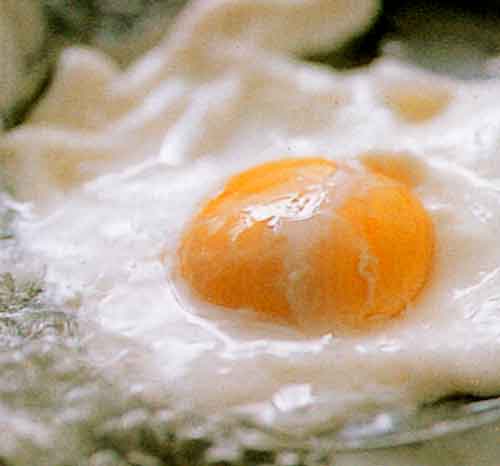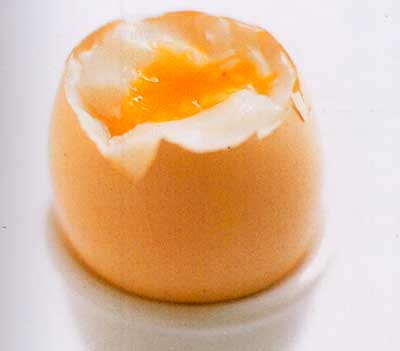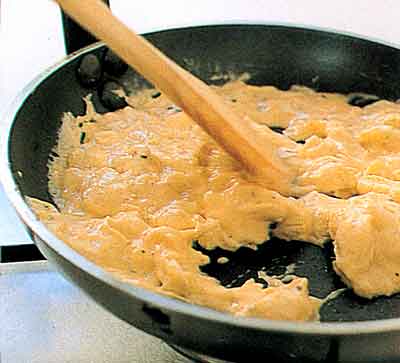Eggs can be the most simple and the most difficult of foods to cook. When you understand a few basic properties of the humble egg, the mystery of cooking the perfect egg unravels.
⇓ You may also listen to the instructions by pressing the play button below
How to Select and Store Eggs

STEP 1: I prefer true free-range eggs for their flavour, and for their bright yolks and thick whites. There are a few good reasons for storing eggs in their carton in the refrigerator.
How to Test Egg For Freshness
| Freshness can be tested in two ways: STEP 1: When it’s cracked onto a plate, the yolk of a fresh egg will sit high and look plump and rounded. The fresh white should be thick and a little cloudy, and cling to the yolk. |
| STEP 2: Drop an egg into a bowl of water. If the egg floats on its side, it is fresh; if it floats vertically with the rounded end up, it is 2-3 weeks old. An egg that floats on the surface of the water has seen better days and should be filed in the rubbish bin. The larger the air pocket in the egg, the older it is. |
How to Poach Eggs

STEP 1: Have a 7-10 cm (3-4 inch) frypan full of rapidly simmering water.
| STEP 2: Break each egg into a cup and gently slip the egg into the pan. |
| STEP 3: Stir the rapidly simmering water to form a whirlpool for a neat oval-shaped poached egg. |
| STEP 4: Allow the egg to cook for 3-4 minutes before removing it from the pan with a slotted spoon. |
| STEP 5: To test for readiness, press the egg with your finger. The white should be firm and the yolk should be soft. |
Tips For Success
| TIP 1: It is sometimes better to use eggs at room temperature, especially when beating whole eggs or egg whites, or using them as an emulsifier. Eggs are extremely sensitive to heat and there may be only a minute between a tender, moist egg and a tough, dry, rubbery egg. |
| TIP 2: When adding eggs to anything hot (such as soups), add a little of the hot substance to the eggs first. |
| TIP 3: Salt relaxes the protein in eggs, making them easier to blend. However, if salt is added to eggs that are to be scrambled, poached or made into an omelette, the eggs will become thin and may break up when cooked. |
How to Boil an Egg

For eggs at room temperature slipped into boiling water:
SOFT: 2-3 minutes
FIRM WHITE, SOFT YOLK: 5-6 minutes
HARD BOILED: 10 minutes
To center the yolk, add the egg to water that has been stirred to create a whirlpool and continue stirring for 1 minute while cooking.
How to Make Scrambled Eggs
| STEP 1: Start by melting a tablespoon of butter in a frypan over medium heat. |
| STEP 2: Place 2 eggs in a bowl and whisk with 1-2 tablespoons of milk or cream. |

STEP 3: Pour eggs and milk into frypan and slowly stir with a wooden spoon. Stir just enough to break up the eggs but don’t over stir so the eggs become a lumpy mass. Scrambled eggs should be soft and creamy with firm pieces of egg throughout. If over cooked, scrambled eggs will weep liquid because of the tightening of the proteins in the egg.
| STEP 4: Add anything you like to scrambled eggs. Additions such as fresh herbs, smoked salmon, aged Cheddar cheese, caviar, salmon roe, sour cream, blue cheese, truffle slices and seasonings should be stirred through just before serving. |
How to Fry An Egg
| STEP 2: Heat 2 teaspoons of oil in a small frypan over medium heat. Break egg shell and gently slip egg into pan. |
| STEP 2: Cook for 1-2 minutes or until egg is, cooked to your liking. |
How to Hard-boil and Shell Eggs

STEP 1: Put the eggs in a medium saucepan of cold water. Bring the water to a boil and simmer the eggs, 10 minutes.

STEP 2: Remove the pan from the heat and immediately run cold water into the pan to stop the eggs cooking. Allow the eggs to cool in the water.

STEP 3: Drain the eggs. Tap gently to crack the shells all over, then remove the shells. Rinse the eggs and dry with paper towels.
NUTRITION FACTS
| Calories: 155 Total Fat: 11 g Saturated fat: 3.3 g Polyunsaturated fat: 1.4 g Monounsaturated fat: 4.1 g Cholesterol: 373 mg Sodium: 124 mg Potassium: 126 mg Total Carbohydrate: 1.1 g Sugar: 1.1 g Protein: 13 g Vitamin A: 10% Calcium: 5% Iron: 6% Vitamin D: 21% Vitamin B-6: 5% Magnesium: 2% |

